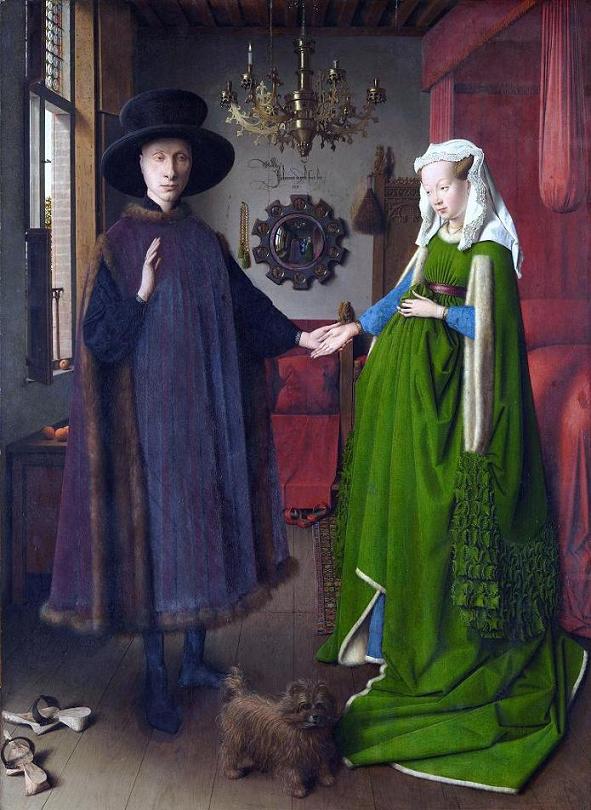
LIFE AS MYTH
![]()
JOURNAL
![]()
JOURNAL 2009
![]()
A feminine myth
Creating a new myth
![]()
SPRING 2009
Mythology of other
![]()
LIFEWORKS
![]()
ATLAS
![]()

SPRING 2009
THE MARRIAGE CODE

The Arnolfini Marriage. Jan Van Eyck. 1434. National Gallery, London. Also known as The Arnolfini Wedding, The Arnolfini Double Portrait or the Portrait of Giovanni Arnolfini and his Wife.
The Arnolfini Marriage by Jan Van Eyck is one of the masterpieces of Western art. Throughout this double portrait, Van Eyck employs a complex iconography to express medieval ideas on sex, procreation, domestic life, wealth, status and gender roles within the context of marriage. For example, the dog at the feet of the couple is a symbol of both fidelity and lust; clogs were a traditional bridal gift and this discarded pair create a link to the Biblical tradition of standing barefoot on holy ground; the solitary candle burning in the chandelier represents both the traditional bridal candle and the all - seeing eye of God.
Medieval marriages were usually arranged unions in which parties of similar social status married to secure a certain standard of living. This was accomplished through the wedding contract, which formally created the union and combined the money, inheritance and property of the couple. Unlike modern marriages, love - based matches during this time were rare. To a large extent marriage was a communal matter not a private one and while medieval society tolerated marital separation, divorce was not available.
Though ostensibly a portrait of Giovanni Arnolfini and his wife, it is not clear which wife is the subject of the painting. Most historians argue that it is a portrait of Arnolfini and his first wife, Constanza Trenta, who was already deceased by 1434. This view has some compelling support within the symbolic iconography of the painting. For instance, in the candelabra over the couple, there are two candles. Directly over Arnolfini, the candle burns. The candle directly over the bride, however, is extinguished. As a result, some art historians believe that this is a memorial portrait, depicting the living alongside the dead, with the flame that still burns over the living Arnolfini and the expired flame over the deceased Constanza. The remaining symbolism in the piece is not inconsistent with this interpretation.
There is an another interpretation. Under that theory, Van Eyck has painted Arnolfini with an unnamed second wife and the portrait serves as a highly original wedding contract. The single most compelling symbol for this interpretation is the convex mirror on the back wall. A close examination reveals not only the back of the bride and groom but two other men as well, one of whom is Van Eyck. Seen this way, the two partially revealed observers are the legal witnesses to the actual second marriage of Arnolfini. The signature of Van Eyck directly over the mirror - - Johannes de eyck fuit hic 1434 (Jan Van Eyck was here 1434) - - can support this theory: that the wedding was a factual event and Van Eyck was present.
There is also another dimension to the mirror. The ornate frame encircling the glass has a series of ten medallions, each one depicting scenes from the Passion of Christ. This juxtaposing of the wedding participants within the circle of the life of Christ creates a larger symbol, one which comments on the intimate ties between medieval society, marriage and faith.

